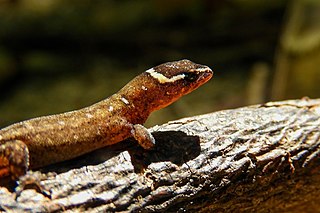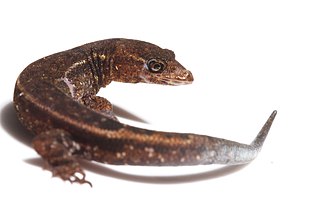
Lepidoblepharis is a genus of Central and South American dwarf geckos in the family Sphaerodactylidae, commonly known as scaly-eyed geckos.

Mastigodryas boddaerti, commonly known as Boddaert's tropical racer, is a species of snake in the family Colubridae. The species is native to tropical South America including Trinidad and Tobago.

Holbrookia maculata, commonly known as the lesser earless lizard, is a species of phrynosomatid lizard endemic to the southwestern and central United States and northern Mexico.

Alexander Grant Ruthven was the President of the University of Michigan from 1929 to 1951.
Lepidoblepharis buchwaldii is a species of gecko, a lizard in the family Sphaerodactylidae. The species is endemic to Ecuador.

Lampropeltis ruthveni is a species of kingsnake in the family Colubridae. The species was described by Frank N. Blanchard in 1920 and named after American herpetologist Alexander Grant Ruthven. It is endemic to Mexico.
Lepidoblepharis conolepis is a species of gecko, a lizard in the family Sphaerodactylidae. The species is endemic to Ecuador.

Lepidoblepharis duolepis is a species of gecko, a lizard in the family Sphaerodactylidae. The species is endemic to Colombia.
Lepidoblepharis grandis is a species of gecko, a lizard in the family Sphaerodactylidae. The species is endemic to Ecuador.
Lepidoblepharis heyerorum is a species of gecko, a lizard in the family Sphaerodactylidae. The species is endemic to northeastern South America.
Lepidoblepharis hoogmoedi, also known commonly as Hoogmoed's scaly-eyed gecko and the spotted dwarf gecko, is a species of gecko, a lizard in the family Sphaerodactylidae. The species is endemic to northern South America.
Lepidoblepharis intermedius is a species of gecko, a lizard in the family Sphaerodactylidae. The species is endemic to northern South America.
Lepidoblepharis microlepis is a species of gecko, a lizard in the family Sphaerodactylidae. The species is endemic to Colombia.

Lepidoblepharis miyatai is a species of gecko, a lizard in the family Sphaerodactylidae. The species is endemic to Colombia.
Lepidoblepharis peraccae is a species of gecko, a lizard in the family Sphaerodactylidae. The species is endemic to western Colombia.
Lepidoblepharis sanctaemartae is a species of gecko, a lizard in the family Sphaerodactylidae. The species is found in southern Central America and northern South America.
Lepidoblepharis williamsi is a species of gecko, a lizard in the family Sphaerodactylidae. The species is endemic to Colombia.

Lepidoblepharis xanthostigma, also known as the yellow-spotted gecko is a species of gecko, a lizard in the family Sphaerodactylidae. The species is found in Central America and north-western South America.
Barbour's clawed gecko is a species of lizard in the family Sphaerodactylidae. The species is endemic to Peru.
Macropholidus ruthveni, known commonly as Ruthven's macropholidus, is a species of lizard in the family Gymnophthalmidae. The species is endemic to northwestern South America.







